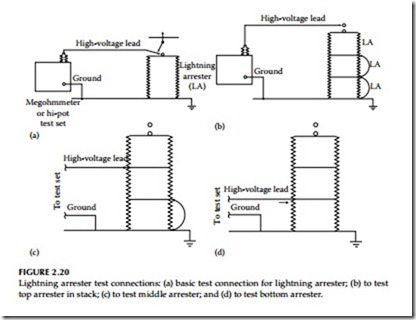Lightning Arresters
The maintenance tests that may be made on lightning arresters with DC voltage is insulation resistance measurement. Following are the generalized maintenance procedures for lightning arresters for conducting the insulation resistance test:
• Apply (usually) 2500 V to line terminal with base grounded with an insulation resistance tester as shown in Figure 2.20. Readings are characteristic of each type of arrester. Some may be as high as 10,000
MΩ; others may be much lower, such as 500 MΩ. The evaluation should be based on comparing readings with previous test results or test values of similar equipment.
• Lightning arresters may also be tested using DC high potential volt- age. The DC voltage should be 1.7 times rated voltage of lightning arresters.
• Field testing of station-class arresters may be accomplished during normal operation by measuring the leakage current through the arrester. Because of the high impedance to ground characteristics of arresters, an increase in leakage current above normal usually indicates a defective arrester. The evaluation of test data should be
Lightning arrester test connections: (a) basic test connection for lightning arrester; (b) to test top arrester in stack; (c) to test middle arrester; and (d) to test bottom arrester.
based upon comparing the leakage current values with previous values or measurements obtained on similar units or comparative values of the three single-pole arresters in the single installation. It is also recommended that oscillographic measurements be made, if possible, because this will provide the most complete information, which allows for the best comparison.
